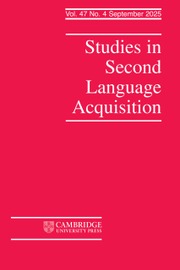Article contents
THE EXPERANTO EXPERIMENT
Effects of Explicit Instruction onSecond Language AcquisitionThis article is based on adissertation project titled “The Influence of Grammar Instruction on Foreign LanguageAcquisition,” which is supported by the Foundation for Language, Speech andKnowledge (under grant 300-73-028), funded by the Netherlands Organization for ScientificResearch (NWO). I thank Jan Hulstijn, Peter Jordens, Huub van den Bergh, Robert DeKeyser,Peter Robinson, Mitsuhiko Ota, and an anonymous SSLA reviewer for theircomments on an earlier version of this article.
Published online by Cambridge University Press: 01 June 1997
Abstract
Theories on the role of consciousness and the enhancement of noticing (Schmidt, 1990,1994; Sharwood Smith, 1993) predict a facilitative effect of explicit knowledge, as built up byexplicit instruction, on the acquisition of implicit second language (L2) knowledge. This studyinvestigates the interaction between the presence or absence of explicit instruction and thevariables complexity and morphology/syntax in the acquisition of four L2 structures. Twogroups of 27 university students, differing in the exposure to explicit instruction, followed acomputer-controlled self-study course in an artificial language. Results from computer-controlledposttests confirm the general hypothesis that explicit instruction facilitates the acquisition of L2grammar. However, no evidence could be reported for the hypotheses predicting a differentialeffect of explicit instruction depending on the variables complexity andmorphology/syntax.
Information
- Type
- Research Article
- Information
- Copyright
- © 1997 Cambridge University Press
- 119
- Cited by

